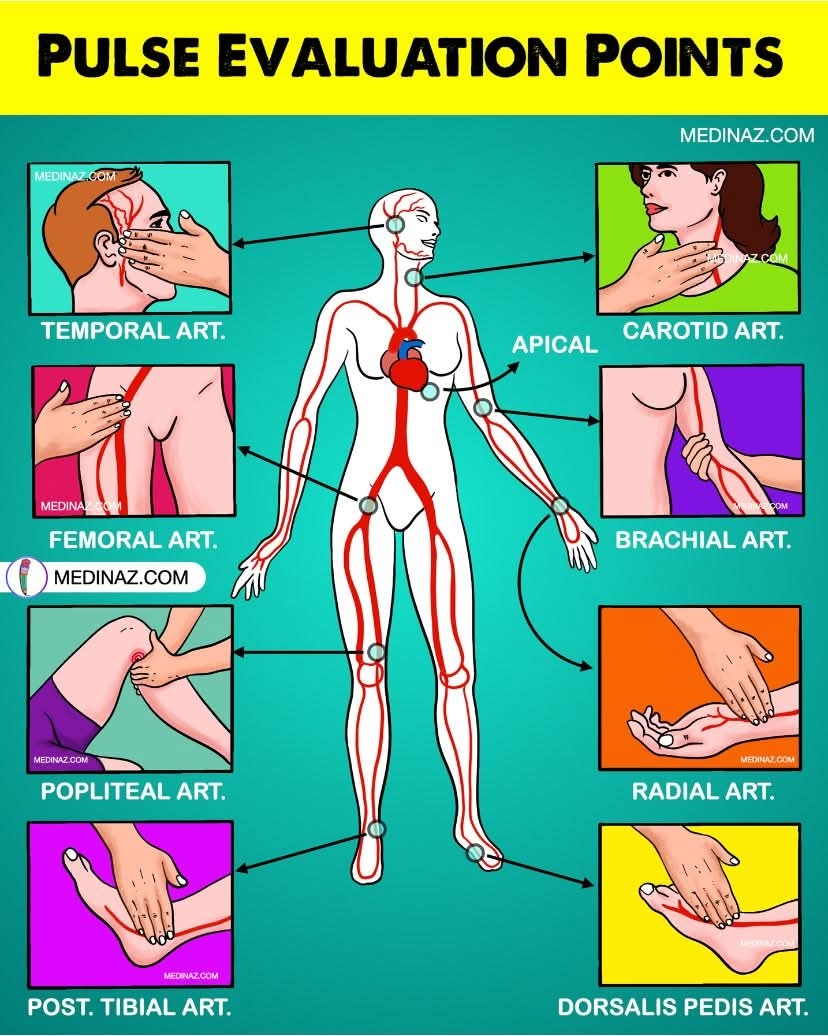Pulse Evaluation: Assessment of arterial pulse points to determine heart rate, rhythm, and circulatory status.
Pulse Points & Their Locations
1. Temporal Artery
Location: Lateral side of the forehead, just above the zygomatic arch.
Clinical Use: Checking pulse in children; evaluating temporal arteritis.
2. Carotid Artery
Location: Anterolateral neck, between the trachea and sternocleidomastoid muscle.
Clinical Use: Checking pulse in emergencies; assessing cardiac output and cerebral perfusion.
3. Apical Pulse
Location: Over the apex of the heart, 5th intercostal space, mid-clavicular line.
Clinical Use: Auscultation preferred over palpation; used for cardiac assessment.
4. Brachial Artery
Location: Medial aspect of the antecubital fossa.
Clinical Use: Blood pressure measurement; evaluating circulation to the forearm and hand.
5. Radial Artery
Location: Lateral aspect of the wrist, proximal to the thumb.
Clinical Use: Common site for pulse checking; assessing peripheral circulation.
6. Femoral Artery
Location: Mid-inguinal point, midway between ASIS (anterior superior iliac spine) and pubic symphysis.
Clinical Use: Assessing lower limb circulation, cardiac output, and shock evaluation.
7. Popliteal Artery
Location: Deep within the popliteal fossa, behind the knee.
Clinical Use: Evaluating circulation to the lower leg, particularly in vascular disease.
8. Posterior Tibial Artery
Location: Behind the medial malleolus of the ankle.
Clinical Use: Assessing peripheral circulation, especially in diabetic patients.
9. Dorsalis Pedis Artery
Location: Dorsum of the foot, lateral to the extensor hallucis longus tendon.
Clinical Use: Checking foot circulation, especially in peripheral artery disease (PAD).
Pulse Points & Their Locations
1. Temporal Artery
Location: Lateral side of the forehead, just above the zygomatic arch.
Clinical Use: Checking pulse in children; evaluating temporal arteritis.
2. Carotid Artery
Location: Anterolateral neck, between the trachea and sternocleidomastoid muscle.
Clinical Use: Checking pulse in emergencies; assessing cardiac output and cerebral perfusion.
3. Apical Pulse
Location: Over the apex of the heart, 5th intercostal space, mid-clavicular line.
Clinical Use: Auscultation preferred over palpation; used for cardiac assessment.
4. Brachial Artery
Location: Medial aspect of the antecubital fossa.
Clinical Use: Blood pressure measurement; evaluating circulation to the forearm and hand.
5. Radial Artery
Location: Lateral aspect of the wrist, proximal to the thumb.
Clinical Use: Common site for pulse checking; assessing peripheral circulation.
6. Femoral Artery
Location: Mid-inguinal point, midway between ASIS (anterior superior iliac spine) and pubic symphysis.
Clinical Use: Assessing lower limb circulation, cardiac output, and shock evaluation.
7. Popliteal Artery
Location: Deep within the popliteal fossa, behind the knee.
Clinical Use: Evaluating circulation to the lower leg, particularly in vascular disease.
8. Posterior Tibial Artery
Location: Behind the medial malleolus of the ankle.
Clinical Use: Assessing peripheral circulation, especially in diabetic patients.
9. Dorsalis Pedis Artery
Location: Dorsum of the foot, lateral to the extensor hallucis longus tendon.
Clinical Use: Checking foot circulation, especially in peripheral artery disease (PAD).
❇️ Pulse Evaluation: Assessment of arterial pulse points to determine heart rate, rhythm, and circulatory status.
🔹 Pulse Points & Their Locations
1. Temporal Artery
Location: Lateral side of the forehead, just above the zygomatic arch.
Clinical Use: Checking pulse in children; evaluating temporal arteritis.
2. Carotid Artery
Location: Anterolateral neck, between the trachea and sternocleidomastoid muscle.
Clinical Use: Checking pulse in emergencies; assessing cardiac output and cerebral perfusion.
3. Apical Pulse
Location: Over the apex of the heart, 5th intercostal space, mid-clavicular line.
Clinical Use: Auscultation preferred over palpation; used for cardiac assessment.
4. Brachial Artery
Location: Medial aspect of the antecubital fossa.
Clinical Use: Blood pressure measurement; evaluating circulation to the forearm and hand.
5. Radial Artery
Location: Lateral aspect of the wrist, proximal to the thumb.
Clinical Use: Common site for pulse checking; assessing peripheral circulation.
6. Femoral Artery
Location: Mid-inguinal point, midway between ASIS (anterior superior iliac spine) and pubic symphysis.
Clinical Use: Assessing lower limb circulation, cardiac output, and shock evaluation.
7. Popliteal Artery
Location: Deep within the popliteal fossa, behind the knee.
Clinical Use: Evaluating circulation to the lower leg, particularly in vascular disease.
8. Posterior Tibial Artery
Location: Behind the medial malleolus of the ankle.
Clinical Use: Assessing peripheral circulation, especially in diabetic patients.
9. Dorsalis Pedis Artery
Location: Dorsum of the foot, lateral to the extensor hallucis longus tendon.
Clinical Use: Checking foot circulation, especially in peripheral artery disease (PAD).
0 Comments
0 Shares
154 Views

